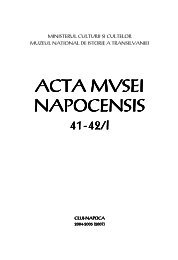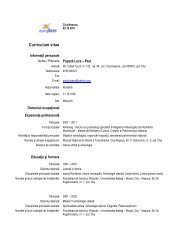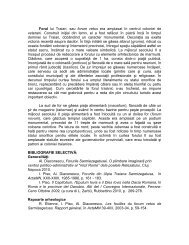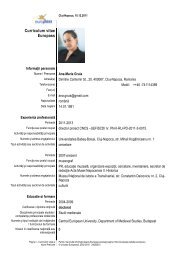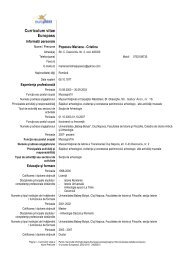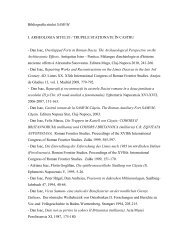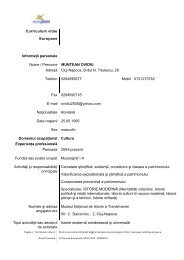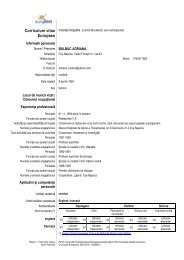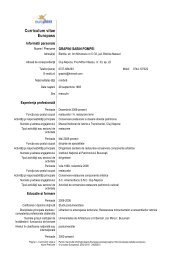43-44/I – Archeology - Muzeul Naţional de Istorie a Transilvaniei
43-44/I – Archeology - Muzeul Naţional de Istorie a Transilvaniei
43-44/I – Archeology - Muzeul Naţional de Istorie a Transilvaniei
Create successful ePaper yourself
Turn your PDF publications into a flip-book with our unique Google optimized e-Paper software.
16<br />
Mihai Wittenberger<br />
the Golourov-type two-handled socketed axes 50 , the sickles with hooks apparently<br />
imitating, “tupic” bone sickles wi<strong>de</strong>spread east of the Carpathians.<br />
Based on the data available, we cannot refer to a discontinuity between<br />
Middle and Late Bronze Age metallurgy, when the Noua culture was present in<br />
Transylvania, quite probably because of the influences of the Wietenberg-tradition<br />
indigenous element, which undoubtedly held the secret of processing tin bronze.<br />
An argument in this respect is bronze processing technology, which has not<br />
changed essentially, but suffered improvements. Thus, from the beginning of the<br />
Middle Bronze Age up to the Hallstattian Age, the percentages of tin in the alloy<br />
only suffered small modifications, in or<strong>de</strong>r to have a better alloy equilibration. The<br />
increase, broken down into stages, ranges between 0.04<strong>–</strong>9%, 1.9<strong>–</strong>7.1%, and 4.1<strong>–</strong><br />
8.4% 51 . What is important is the increase of the average and the emergence of a<br />
Transylvanian “local mark”, with about 3% Fe. Corroborating data from<br />
Transylvania with the information provi<strong>de</strong>d by Chernîkh related to the chronology<br />
of copper and bronze artefacts, one can notice that artefacts ma<strong>de</strong> of a Cu-Sn alloy<br />
emerged in about the same historical moment in: Syria, Altai, Central Asia and,<br />
last but not least, the Carpathian area, all around 2000<strong>–</strong>1800 BC 52 . Un<strong>de</strong>r these<br />
circumstances, I believe that the above-mentioned i<strong>de</strong>a, according to which the<br />
Cu-Sn alloy would have an eastern origin lacks archaeological support. It is much<br />
more natural to consi<strong>de</strong>r that the same technological phenomenon was taking place<br />
in about the same historic moment, in different places.<br />
I believe that the quantitative and qualitative leap is the result of the local<br />
Wietenberg tradition interferences with a great cultural area: the eastern-European<br />
one, represented by the Noua and the entire series of <strong>de</strong>posits Uriu-Domăneşti. An<br />
argument in this respect is the socketed axe group from Oinac in the southern<br />
Carpathians, which imitates the Transylvanian-type socketed axe 53 , pl. 16. There is<br />
a <strong>de</strong>posit type to attest Transylvania in the “Noua period”, characterised by a<br />
relatively reduced number of items and by the uniformity of the inventory. These<br />
items are small, mostly unbroken, usually sickles, socketed axes, and spearheads:<br />
Mociu 54 , pl. 9, Cîmpeneşti, Cluj County. This is the fundamental difference<br />
between the “Noua Age” and the early Hallstattian age, in which almost all the<br />
pieces discovered had been intentionally broken, like in Vîlcele II 55 or Uioara 56 .<br />
50<br />
Dergacev 1997, 138.<br />
51<br />
Petrescu-DîmboviŃa 1977, 18.<br />
52<br />
Cernîkh 1992, 67<strong>–</strong>71.<br />
53<br />
Petrescu-DîmboviŃa 1977, 78<strong>–</strong>79.<br />
54<br />
Petrescu-DîmboviŃa 1977, 64, pl. 56, with ol<strong>de</strong>r bibliography.<br />
55<br />
Soroceanu 1988, 249<strong>–</strong>261.<br />
56<br />
Soroceanu, Istrate 1975, 32; Petrescu-DîmboviŃa 1977, 23<strong>–</strong>24, pl. 114<strong>–</strong>117.



